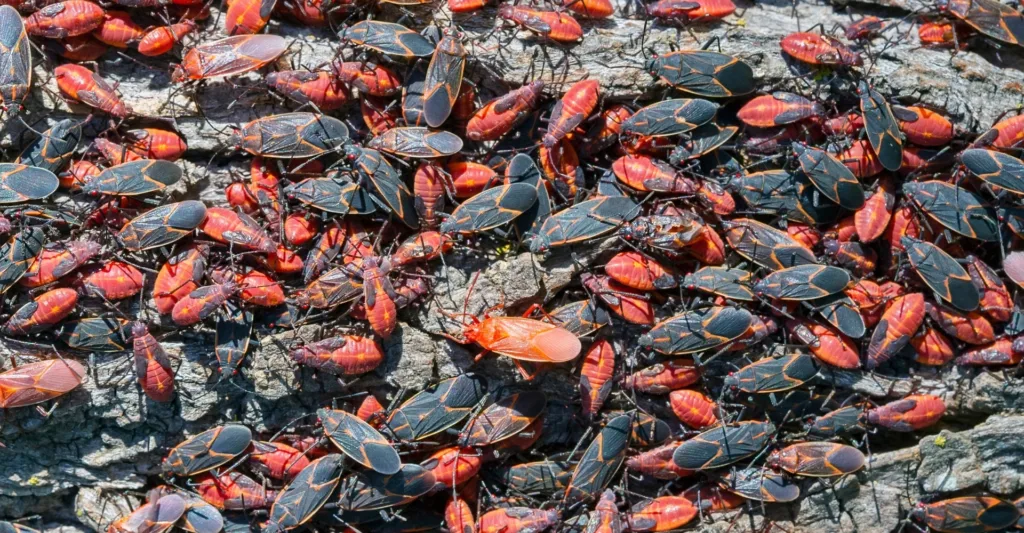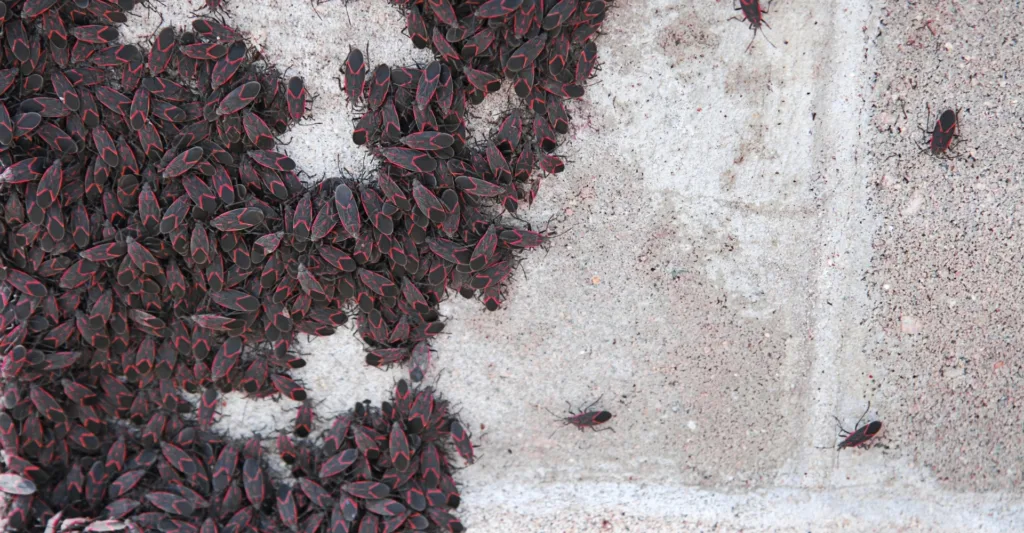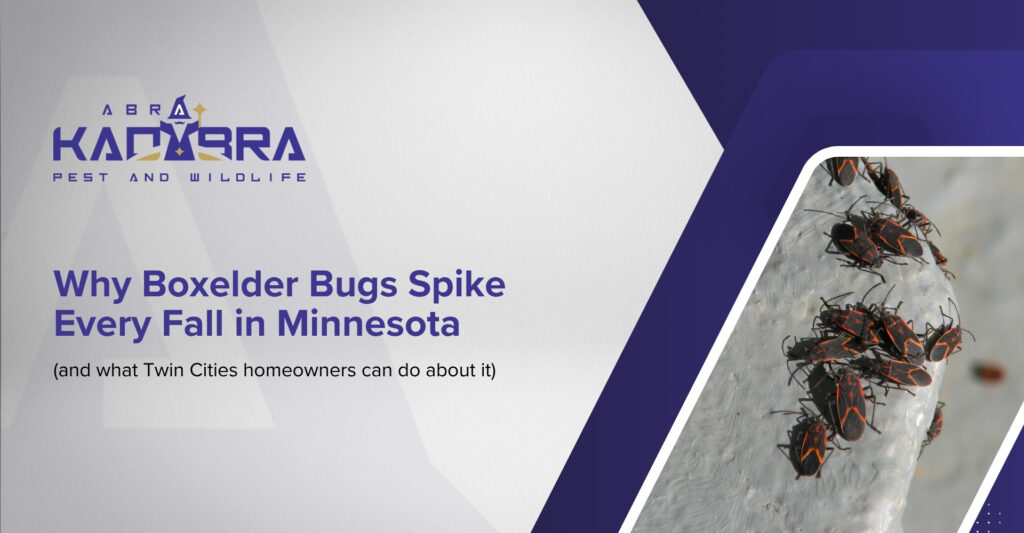If you live in the Twin Cities or the greater Minnesota metro, you’ve probably noticed them: clusters of black-and-orange insects sunning themselves on the south or west sides of houses, or sneaking into garages, attics, and wall voids as the weather cools.
Boxelder bugs are one of the season’s most apparent pests, despite being relatively harmless. But why do their numbers seem to explode every autumn in Minnesota, and what should homeowners in Minneapolis–Saint Paul actually do about them? Below: the how, the why, and practical steps to keep your home boxelder-bug free.
What are boxelder bugs, and how to Identify Them
They feed primarily on the seeds and developing tissues of boxelder trees (a type of maple), though they’ll also be found on maples and ashes. Most importantly for homeowners, adults overwinter in protected crevices and will seek buildings as suitable overwintering sites.
Lifecycle highlights relevant to fall behavior:
- Adults emerge in spring, feed, and mate.
- They congregate on seed-bearing female boxelder trees in mid-summer.
- Late summer–early fall, they disperse, looking for warm, sheltered sites to overwinter.
These lifecycle steps explain why you may not notice large numbers until late summer and especially fall.
Why do boxelder bugs spike in the fall in Minnesota?
Several ecological and seasonal factors combine to produce the classic Minnesota autumn “boxelder bug problem”:
- Population booms follow hot, dry summers.
Boxelder bug populations historically surge after warm, dry seasons (records show big outbreaks during the Dust Bowl years and other hot, dry summers). Drought-type summers reduce natural mortality and create conditions where nymph survival and reproduction are higher, which means more adults heading into fall seeking overwintering sites. Recent Minnesota reports link higher fall sightings to hotter, drier summers. - They seek warmth, and aggregations are adaptive.
As temperatures drop, boxelder bugs move to sunny, warm surfaces (southern or western exposures on trees and buildings) to bask and conserve energy. Aggregating in groups amplifies the warming effect and makes finding mates and sheltered microhabitats easier. That’s why you see dense clusters on the sunny side of houses, fences, and trunks. - They’re searching for overwintering cracks and cavities.
Adult boxelder bugs look for small cracks, gaps around windows, siding joints, soffits, and attic vents to overwinter. Once they find a protected spot, they remain relatively inactive through the cold months, then reappear inside buildings in late winter or early spring when temperatures warm. They can fly or move several blocks — in some cases, much farther — to reach suitable shelter. - Human structures unintentionally provide ideal wintering habitat.
Modern homes with warm, sunny exteriors may have small entry points and sheltered wall voids/attics that often resemble natural rock crevices or tree bark to boxelder bugs. So even a modest local population can look enormous when thousands gather at preferred sites on houses across a neighborhood.
Are boxelder bugs dangerous?
No, they’re mainly a nuisance.
- Boxelder bugs don’t bite people (except for an occasional, minor puncture if handled roughly), and they’re not known to spread disease.
- They don’t cause structural damage to homes, and their feeding on trees is generally superficial (mostly seeds/leaf tissues) and not fatal to trees.
They can stain surfaces and emit an unpleasant odor if crushed, so crushing them indoors is not recommended. Vacuuming or gently removing them is better.



Dealing with Boxelder Bugs, the Minnesotan Way
Because boxelder bugs are primarily a nuisance pest that congregates to overwinter, the best approach for Twin Cities homeowners is exclusion and habitat reduction, combined with targeted professional options if needed. Here’s a season-by-season, practical plan:
Inspect and seal: Walk the exterior of your home and seal gaps around windows, doors, soffits, utility penetrations, and foundation seams. Insects can enter through cracks as narrow as a few millimeters; weatherstripping and caulk are inexpensive and effective solutions. Do this before heavy aggregation starts.
Reduce nearby harborages: Move woodpiles away from foundations, clear leaf litter, and trim back dense vegetation near the house—these reduce sheltered microhabitats that boxelder bugs favor.
Consider targeted perimeter treatments: For homes experiencing large gatherings, targeted exterior perimeter treatments on sunny walls and around potential entry points can help reduce the number of bugs before they enter the home. If you hire a pro, ask about timing (fall is best) and impacts on pollinators and pets.
If they get inside
Don’t crush them.
Locate and seal new entry points.
When to call a professional
If you’re seeing hundreds or thousands of insects on your structure, or repeated indoor invasions, professional help can provide targeted exclusion work and perimeter treatments that are timed and applied safely. Local pros know the Minneapolis–Saint Paul microclimates and the best product/timing trade-offs for Minnesota. If you’d like help, our Boxelder Control Services page explains how we manage them in the Twin Cities; you can also request an inspection from our Pest Team or contact us for a quote.
What professional technicians do (and what you should ask them)
When hiring a pest company in Minnesota, a good service will:
Inspect for entry points and recommend or perform sealing work.
Apply targeted exterior treatments in the fall to reduce numbers before they enter.
Offer advice on long-term habitat reduction (tree seed management, trimming, clean-up).
Discuss safety for children, pets, and pollinators when treatment is recommended.
You can read more about our local approach on our Residential Pest Control page and our deeper boxelder guide, “Everything You Never Wanted to Know About the Boxelder Bug.”
In Conclusion
Boxelder bugs are a seasonal nuisance, not a structural threat.
Their fall spike in Minnesota is driven by weather, lifecycle timing, and the search for warm overwintering sites. Thoughtful exclusion work, habitat reduction, and brilliant timing (act in late summer/early fall) will keep most homes clear.
For larger problems, a local Minnesota pest pro can apply targeted, safe control measures and sealing strategies to give you peace of mind through the colder months. If you’d like an on-site evaluation tailored to Minneapolis–Saint Paul microclimates, get in touch — we’re happy to help.

